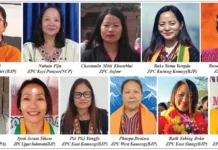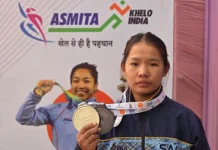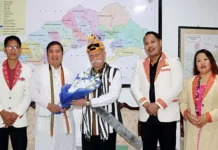[Lucia Panggeng, Prem Taba & Keyom Doni ]
In May of this year, government schools in Arunachal Pradesh once again exhibited a disappointing performance in the All-India Secondary School Examination (AISSE) for the 2022-’23 academic year. In response to this underwhelming performance, Taba Tedir, the state’s education minister, undertook a comprehensive review on 1 August. The evaluation focused on the key initiatives introduced by the education department for the upcoming academic session of 2023-’24.
This evaluation meeting was held at the SCERT office in Itanagar, with the presence of prominent figures, including the commissioner of education, the secretary of education, and the special secretary. The subsequent day, local newspapers featured the meeting with the headline ‘Tedir reveals ambitious education reforms for 2023-’24 academic session’.
Although a press release was issued to the public, detailing the outcomes and resolutions of the meeting, which is readily accessible, it is crucial to acknowledge its positive aspects while also addressing its notable shortcomings. In light of this, the authors of this article have scrutinised the proceedings and have presented suggestions to address the perceived gaps in the initiatives.
The press release highlights the education department’s emphasis on an inclusive, innovative, and learner-centric education system that resonates with the current global trends in education. The focus on holistic development and equipping students with skills for the 21st century reflects a forward-looking approach.
One significant aspect of the review pertains to teacher training and professional development. The minister rightly recognises the importance of enhancing teaching methods and approaches within classrooms. The call for a training calendar and feedback mechanism reflects a proactive stance towards ensuring the effectiveness of teacher training. The emphasis on developing training materials and evaluating resource persons showcases a commitment to improve the quality of training programmes, a critical factor in elevating the overall education scenario.
The minister’s attention to strengthen the district institutes of education and training (DIET) highlights their pivotal role in teacher educator professional development. This acknowledgment is essential for enhancing the capacity of the DIETs to support teachers’ growth effectively. Additionally, the proposed field survey of training inputs demonstrates a commitment to evidence-based decision-making and aligning training programmes with the needs of teachers.
The integration of technology in education through online telecasts of training and the launch of dedicated channels for digital learning is a commendable step. The focus on utilising the PM e-VIDYA platform to facilitate digital learning is aligned with the broader national initiatives, making education more accessible and flexible.
The review meeting’s outlined initiatives hold promise, yet there exist areas warranting deeper contemplation. Retrospectively, the mechanism is overly fixated on teacher training, overlooking other potential factors contributing to the dismal performance. Arunachal Pradesh, a relatively youthful state unlike its counterparts, possesses distinctive geographical, socio-cultural, and demographic attributes. Unique aspects requiring special attention vary across regions. For example, efforts and outcomes greatly contrast between the remote, road, and internet-deprived Kurung Kumey and East Siang districts.
Merely providing teacher training, devoid of robust accountability measures, adequate infrastructure, educator and student motivation, and guardian sensitisation proves ineffectual. It’s imperative to ponder a potential overhaul of the teacher recruitment system or specialised area-oriented training. Notably, even the central government acknowledges such complexities by placing education in the concurrent list. Hence, a one-size-fits-all approach, fixated on a single aspect without unearthing the root causes, is unproductive, squandering human and material resources. A comprehensive reevaluation of the approach is paramount.
An in-depth investigation is needed to uncover the multifaceted causes and guide the creation of precise tools, materials, and strategies. This involves constituting three committees aligned with Arunachal’s eastern, western and central regions, further divided into soft and hard belts. Each committee should comprise individuals with either an MEd degree or research scholars delving into education-related or underprivileged topics. These experts will facilitate tool and material development and carry out a 4-to-6-month field study, supported logistically.
Post data collection, analysis follows, leading to outcomes presented to the relevant authorities. This paves the way for initiating necessary actions, including teacher training, programme enhancement, and tool/material development. While teacher training remains vital, education policies must adopt a learner-centric approach for comprehensive development. With student performance at a nadir, an exhaustive research endeavour, guided by experts, can conceive holistic, innovative, inclusive, and learner-oriented policies.
The press release could also have provided more details on the bagless Saturday programme, learning recovery programme, and centralised assessment to give a clearer understanding of their objectives and expected impact. Additionally, the press release could have included data or evidence showcasing the progress and outcomes of previous education initiatives in the region to provide context for the current efforts.
The first notable area for improvement is the need for concrete outcomes. The press release discusses various initiatives but falls short in outlining specific details regarding anticipated results and the potential impact of these endeavours. The inclusion of quantifiable goals and targets would substantially enhance the clarity of the government’s educational vision.
To bolster credibility, the education department could benefit from incorporating data or evidence that substantiates claims of educational progress within the state. By presenting statistics on areas like improved student performance, decreased dropout rates, and heightened teacher qualifications, the release could lend more weight to its assertions.
While the press release acknowledges the importance of teacher training, it could delve deeper into how these training programmes will directly tackle classroom challenges, teaching methodologies, and student engagement. Incorporating real-world examples of innovative training techniques would enrich the narrative.
An area of importance that the press release touches on briefly is resource allocation. However, a more comprehensive understanding of the successful implementation of these initiatives could be achieved through a discussion of funding commitments and the allocation of additional personnel. In addition, the significance of parent and community engagement should not be overlooked. The press release mainly centres on teacher training and governmental initiatives, but involving parents and local communities in the education process can significantly augment student outcomes. This aspect could be acknowledged and addressed more explicitly.
Furthermore, to ensure sustainability of these initiatives over the long term, the press release could elaborate on the government’s plans for maintaining these efforts beyond the current academic year. Insights into strategies that guarantee the continuity of these endeavours would offer valuable perspective.
To further uplift education in Arunachal, several measures are suggested. These include empowerment of teachers through a comprehensive training programme, encompassing pedagogical training and subject expertise enhancement. Incorporating regular workshops, peer mentoring, and teacher collaboration would contribute to continuous professional growth. In conjunction with the PM e-VIDYA initiative, focus on ensuring that schools have dependable internet connectivity and necessary technological resource is recommended. This will facilitate effective online learning and remote education.
To make informed policy decisions, establishing a robust data collection and analysis system for monitoring student performance, teacher effectiveness, and infrastructure requirements is crucial. Given the linguistic diversity of the state, prioritising the creation of educational materials in local languages can enhance comprehension and engagement among students. Engaging parents, community leaders, and local organisations in education planning and implementation can foster a sense of ownership and accountability, thereby benefiting the overall educational landscape. Investing in improving school infrastructure, including classrooms, libraries, and laboratories, is vital to creating an environment conducive to effective learning.
Moving beyond traditional assessment methods and exploring innovative ways to evaluate students’ holistic development, including life skills, creativity, and critical thinking, is encouraged. Developing a transparent and fair system for evaluating teacher performance can help identify strengths and areas for improvement. Formulating a comprehensive long-term education strategy that outlines goals, targets, and key performance indicators for the upcoming years is essential for sustained progress. Conducting public awareness campaigns to inform parents and students about available educational resources, initiatives, and the benefits of a quality education is recommended.
Implementing measures to ensure that children with disabilities or from marginalised communities have equal access to quality education underscores the importance of inclusivity. Encouraging educational research and innovation through partnerships with local universities and institutions can yield effective teaching methodologies and educational tools. By incorporating these measures into existing initiatives, Arunachal can undergo a comprehensive and impactful educational transformation.
In conclusion, the enhancement or uplift of any system, particularly when the final outcomes fall short of expectations, necessitates a comprehensive study to be carried out promptly. This should be followed by a systematic reconstruction of the system. At present, our state is endowed with an ample number of qualified human resources, possessing the competence to engage in research, devise mechanisms and tools, and contribute inventive and all-encompassing insights to elevate the state of the existing school education system. Historically, numerous groundbreaking educational policies have emerged subsequent to the establishment of research committees, underscoring the pivotal role of research. Hence, it is now opportune for our state to embark on an extensive localised research initiative within the education sector. This endeavour will not only aid in discerning the underlying challenges but also facilitate identification of effective solutions, thus reinforcing governmental efforts. (Lucia Panggeng and Prem Taba are research scholars at RGU, while Keyom Doni is an MA psychology student.)




